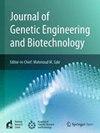光甘草的甘草异黄酮B和光甘草定作为拉沙病毒的有效核蛋白拮抗剂:来自分子对接、动力学模拟、PCA和DFT研究的见解
IF 2.8
Q3 Biochemistry, Genetics and Molecular Biology
Journal of Genetic Engineering and Biotechnology
Pub Date : 2025-08-05
DOI:10.1016/j.jgeb.2025.100544
引用次数: 0
摘要
拉沙病毒引起严重的出血性疾病,称为拉沙热。西非和中非人民的死亡率很高。目前,没有可用的疫苗,利巴韦林是唯一的治疗选择,具有明显的局限性。鉴于缺乏有效的药物,本研究从甘草植物中探索生物活性植物化合物,可能比利巴韦林更安全、更有效地对抗病毒的核蛋白活性,这是病毒复制和宿主免疫逃避所必需的。通过对该植物69种天然植物化学物质的虚拟筛选和多阶段分子对接分析,发现licoisoflavone B和光甘草定具有潜在的治疗作用。这些化合物对靶蛋白具有很强的结合亲和力,具有优越的ADMET谱。在100 ns的分子动力学模拟中,这两种化合物都保持了结构稳定性,而主成分分析进一步证实了它们的构象稳定性,突出了潜在的效率。此外,密度泛函理论分析表明,该化合物具有良好的电子特性,支持其作为可行的候选药物的潜力。这些发现提示licoisoflavone B和光甘草定是拉沙热的潜在治疗候选者。然而,这项研究强调了进一步实验验证以推动这些化合物成为新型抗拉沙病毒治疗药物的紧迫性。本文章由计算机程序翻译,如有差异,请以英文原文为准。
Licoisoflavone B and glabridin from Glycyrrhiza glabra as potent nucleoprotein antagonists of Lassa virus: insights from molecular docking, dynamics simulation, PCA, and DFT studies
Lassa virus causes a severe hemorrhagic disease referred to as Lassa fever. It exhibits a significant mortality rate among people in West and Central Africa. Currently, there is no vaccine available, and ribavirin is the sole treatment option with significant limitations. Given the lack of an effective medication, this study explores bioactive phytocompounds from the plant Glycyrrhiza glabra that may be safer and more effective than ribavirin in combating viruses’ nucleoprotein activity, which is essential for the replication of viruses and host immune evasion. Our virtual screening and multi-stage molecular docking analyses of 69 natural phytochemicals from this plant revealed the compounds licoisoflavone B and glabridin as potential therapeutics. These compounds exhibit strong binding affinities toward the target protein, with superior ADMET profiles. Both compounds also maintained structural stability throughout 100 ns molecular dynamics simulations, while principal component analysis further corroborated their conformational stability, highlighting potential efficiency. Furthermore, density functional theory analysis indicated favorable electronic properties, supporting the compounds’ potential as viable drug candidates. These findings suggested licoisoflavone B and glabridin as potential therapeutic candidates for Lassa fever. However, this study underscores the urgency of further experimental validation to advance these compounds toward novel anti-Lassa virus therapeutics.
求助全文
通过发布文献求助,成功后即可免费获取论文全文。
去求助
来源期刊

Journal of Genetic Engineering and Biotechnology
Biochemistry, Genetics and Molecular Biology-Biotechnology
CiteScore
5.70
自引率
5.70%
发文量
159
审稿时长
16 weeks
期刊介绍:
Journal of genetic engineering and biotechnology is devoted to rapid publication of full-length research papers that leads to significant contribution in advancing knowledge in genetic engineering and biotechnology and provide novel perspectives in this research area. JGEB includes all major themes related to genetic engineering and recombinant DNA. The area of interest of JGEB includes but not restricted to: •Plant genetics •Animal genetics •Bacterial enzymes •Agricultural Biotechnology, •Biochemistry, •Biophysics, •Bioinformatics, •Environmental Biotechnology, •Industrial Biotechnology, •Microbial biotechnology, •Medical Biotechnology, •Bioenergy, Biosafety, •Biosecurity, •Bioethics, •GMOS, •Genomic, •Proteomic JGEB accepts
 求助内容:
求助内容: 应助结果提醒方式:
应助结果提醒方式:


